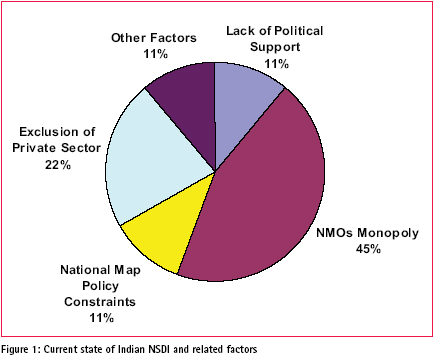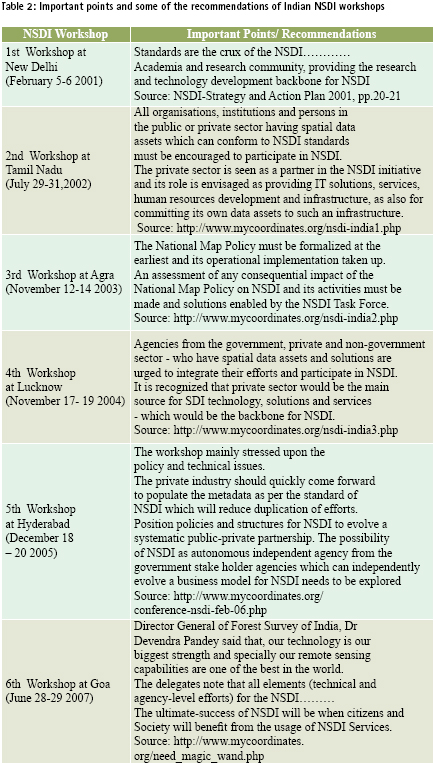| SDI | |
Is Indian NSDI an example to follow?
|
Asmat Ali |
|
The exclusion of end users also made it impossible to bring social aspects of NSDI in the terminology of Georgiadou ‘Social SDI’ and it became a ‘technical SDI’. About the exclusion of state governments, the then Surveyor General of India in the July 2006 issue of Coordinates (http:// www.mycoordinates.org/indias-nsdijuly06. php) said, “The other area of concern is to involve state governments. We need to think how to get them on board through state level SDI”. And “Although major data producing agencies are at central level but at micro level most of the datasets are with the state governments” he further added. He also realized the difficulties of implementation saying that, “The challenge as Member Secretary is the implementation of an action plan within a given timeframe”. In the February 2006 issue of GIM International (http://www.giminternational. com/issues/articles/id614- Multilevel_Implementation_of_SDIs. html), Masser writes, “Many national SDI documents seem to abide by the principle of ‘one size fits all’; they suggest that the outcome of SDI implementation will lead to a relatively uniform product…… National SDI strategies drive statewide SDI strategies and state-wide SDI strategies drive local-level SDI strategies”. Therefore, participation of local stakeholders i.e. states, end users, private sector GI organizations, academia and NGOs is very crucial for implementation of an NSDI. As most detailed database maintenance and updating tasks are carried out at local level, the input of local government has a considerable impact on SDI implementation at state and national levels, (Masser 2005). In the August 2007 issue of Coordinates (http://www. mycoordinates.org/nsdi_august2007.php) Mukund Rao former president GSDI also showed his concerns about participation of few stakeholders in Indian NSDI in these words, “….was driven by a few individuals for success and benefit in the country”. He also underscores the need of PPP for NSDI in these words, “Another major amalgam for NSDI is Public-Private partnerships – it would be just impossible for a single entity (even government) to fully establish the NSDI on its own. Partnerships will have to be the core mechanism to make NSDI successful.” How was Indian NSDI implementated?NSDI implementation is a complex process. In addition too many stakeholders in the game as is the case of Indian NSDI make it more complex. The gravity of the situation increases further when major players are not included such as private sector and end user groups which is true also in Indian case as Georgiadou et al. (2005) also finds, “The Indian NSDI shows little evidence of systematic interaction between its developers (the scientific institutions) and potential end users (for example, district administration) to understand their information needs”, (p.1123). There is no much evidence of any partnership arrangements including PPP though “PPP” is there on papers of Indian NSDI workshops and in the statements given by Indian ministers to the print media. To quote an example, science and technology minister Kapil Sibal said in a statement published by The Times of India on 19th February, 2007, “The government proposes to make all this information available through public-private partnerships”. Indian NSDI followed top-down approach termed as “construction approach” by Georgiadou giving it bit mechanical meaning. According to her, “The topdown approach is required to specify a strategic goal and vision, prioritize plans, arrange core funding, contribute to the definition of fundamental datasets, build a clearing house, develop metadata standards, and resolve information policy issues”, (Georgiadou et al. 2005, p.1123). Simply said it revolves around planning and lacks in implementation terms as implementation is more encouraged by bottom-up approach because implementation requires local participation which is present in bottom-up approach according to Georgiadou et al, “The bottom-up approach aim to promote various local initiatives”…, (Georgiadou et al. 2005, p.1123). Therefore, adoption of top-down approach in addition to the exclusion of key stakeholder groups like private sector, academia and NGOs made successful implementation of Indian NSDI a dream instead of reality. What has been the over all trajectory of Indian NSDI?A questionnaire was designed and distributed via e-mail to get input from individuals of public and private GI sector organizations in India. The questionnaire response rate was 60%. Some of the respondents sent very detailed e-mails in addition to questionnaire reply in the context of Indian NSDI. It indicated keen interest of individuals both from public and private GI sector of India regarding NSDI. Most of the respondent i.e. 45% individuals declared monopoly of national mapping organizations (NMOs) as the main reason for current state of Indian NSDI. 22% respondents were of the opinion that Indian NSDI suffered due to exclusion of private sector where as 11% individuals considered national map policy the major bottle neck in successful implementation of Indian NSDI. The same majority i.e. 11% attributed current state of Indian NSDI to lack of political support while remaining 11% respondent considered it due to other factors such as noninvolvement of NGO and academia etc. The result of the survey is displayed in figure 1. Workshops arranged by coordinating body of Indian NSDI also help to understand path followed by Indian NSDI. The following table (Table 2) summarizes the important points and some of the recommendations of Indian NSDI workshops held so far in order to have a brief view of Indian NSDI initiative as perceived by the NSDI coordinating body. Arguments made up till now covered some important aspects such as important elements, stakeholders, partnership arrangements and implementation strategy of Indian NSDI. Therefore, starting from vision statement in 2001 to last NSDI workshop held at Goa in 2007, marks the trajectory of Indian NSDI. |













 (No Ratings Yet)
(No Ratings Yet)





